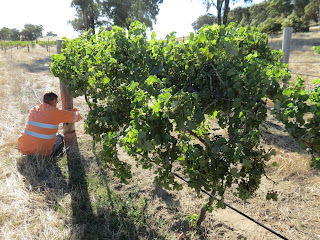Being complete amateurs in viticulture, we were most reluctant to take on the task of rejuvenating our newly acquired vines. They were in desperate need of some help as they had not been pruned or reticulated for a couple of years. We left them as long as we could, hoping that they would magically sort themselves out. This did not happen. So with great trepidation we watched every available You Tube video on grape vine care and set out into the vineyard armed with very little knowledge and about the same amount of hope. We decided that we had left it too late to prune the vines (secretly sighing with relief that we did not have to bungle our way through that task). That would just have to wait until next year- we were so disappointed! (teehee). We decided to just train this year's growth over the wires (seemed easy), fix the broken reticulation (we could probably manage that without too many difficulties) and let nature take its course (hey, not even our problem from that point forward). We planned to be on top of it all next year, reading, studying, buying new shears and other paraphernalia which would somehow assist us with our struggles, then promptly forgot about the vines and started planning our next holiday to Europe (yeeehah!).
Below: The neglected vineyard in need of some tender loving care, and quite possibly expert attention. Unfortunately what it was about to get was some amateur quick fix therapy and a little more neglect! One day we will replace the missing vines......
We spent the next few days on our hands and knees replacing drip heads and hose lines and contemplating removing the vines and setting up horse agistment in their place.
Hard at work replacing blocked and broken drip sprinkler heads and split pipes.
It is nice to have a little bit of greenery during the long dry summer! But, my oh my, wouldn't the sheep love to be in here with all that rye grass and those nice juicy green leaves.
The vines still produced plenty of grapes, even without water, fertiliser and with the bare minimum level of general care. They are survivors- maybe they are just what we need considering our general inertia!
Powdery mildew showed its ugly head towards the end of the season, but what can you do?
Greenery during an otherwise brown, dry period- makes having the vines seem almost worthwhile!
So now we had to decide what to do with the grapes! Well aware of the fact that we had no idea how to make wine and no equipment with which to make it, we did consider just feeding them to the ducks. And because they were not table grapes but instead wine grapes (Chardonnay, Verdelho and Merlot) we were presented with our first problem. No-one really wants wine grapes. Apparently there is a glut of the things world wide! Poor Ivor (the man who planted the grapes in the first place) he obviously did not foresee the world wide overproduction of wine grapes and olives and consequential slump in prices! Just as well his retirement wasn't reliant on them for an income. "What to do with something no-one seems to want?", I thought. Best to turn it into something people may actually contemplate buying. But what?? Then I was struck with the old "light bulb moment"- let's make wine jelly.
So I looked up a few recipes on the internet (Gotta love the internet!) and came across a recipe for Merlot jelly and Chardonnay jelly. I made the initial batch last season, just to try it out and get some reactions from others. The jellies have proved popular- like Cranberry jelly- and very, very nice on meat and cheeses.
Merlot Jelly. Here is the recipe I followed
- Ingredients
- 1 kg Merlot or Chardonnay grapes with seeds
- 450 g jam sugar (with added pectin)
- juice 1 lemon
- Method
- Put grapes into a large saucepan set over a low heat. Cover and simmer for 5 mins until the juices start to run. Take a potato masher and mash up the grapes. Cook for about 10 mins, mashing intermittently until the grapes are falling apart. Place a clean tea towel in a sieve set over a bowl. Pour the grape mixture in an let it drip through for at least 1 hour, overnight if possible.
- Measure out 600 mls of juice and pour it into a pan with the sugar and lemon juice. Bring to the boil. Skimming any scum as it boils, let the mixture bubble until the temperature reaches 105C on a sugar thermometer. Pour the hot jam into a sterilised jar. This jam will keep unopened for 3 months.
So the future of the grape vines looks a little more secure as they enter their second year under our care. We will, at some future date, yet to be confirmed, turn the grapes into jellies instead of wines. We will need a commercial kitchen for this endeavour so it is not on the top of the "to do" list at the moment! But the trial and error of looking after the grapes has proved interesting and a little rewarding. And besides, the grape leaves make a great treat for the sheep at the end of the growing season- and who doesn't love seeing the beautiful sheep enjoying a special treat!












No comments:
Post a Comment